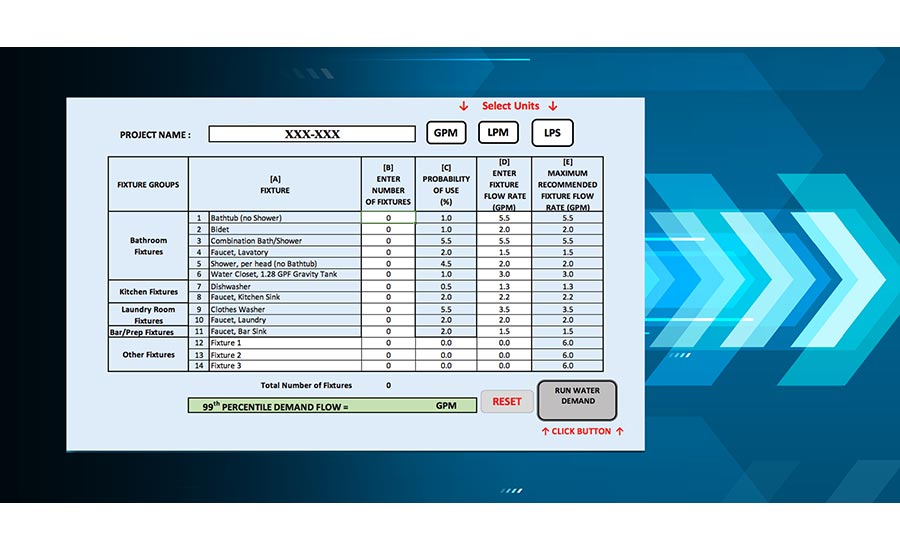Plumbing engineers and designers have been talking about it for what seems like forever. Plumbing installers have been looking into ways to become more efficient. Plumbing manufacturers have been collecting the data to better size their equipment. And plumbing inspectors and plan reviewers have been acutely aware of the need for change for a long time.
Of course, anyone in the plumbing industry knows what I am talking about is the Hunter’s Curve. And, in the U.S. plumbing industry, there has been widespread consensus that we have been oversizing our domestic water systems for decades. While the work Roy Hunter completed in 1940 was revolutionary for the time, we all agree that it is well past time to update the way we size these systems.
Most of the plumbing engineering industry is already aware that IAPMO, ASPE and the University of Cincinnati collaborated to create the Water Demand Calculator — also known as the WDC — and that the WDC ultimately was added to the 2018 UPC as “Appendix M.” This marked the first time in almost 80 years that an alternative to Hunter’s Curve pipe sizing methodology was added to a model code. The benefits were quickly apparent as Stantec identified in its report. The benefits mentioned include:
- Up to 11% cost savings on copper piping (based on pre-pandemic material costs);
- Up to 16% cost savings on PEX piping (based on pre-pandemic material costs);
- Improving water quality by reducing water dwell times;
- Faster hot water delivery and improved energy efficiency; and
- Less water stored inside plumbing systems can help improve water conservation efforts.
 The WDC was added to the 2018 UPC as “Appendix M.” This marked the first time in almost 80 years that an alternative to Hunter’s Curve pipe sizing methodology was added to a model code.
The WDC was added to the 2018 UPC as “Appendix M.” This marked the first time in almost 80 years that an alternative to Hunter’s Curve pipe sizing methodology was added to a model code.
Additionally, the Alliance for Water Efficiency (AWE) completed a study showing the incredibly positive economic impacts to home builders that reduced utility/water-meter connection fees had as a result of utilizing the WDC. The only drawback? The WDC is meant to be applied only to residential buildings, either single or multi-family (such as a high-rise condo/apartment). Offices, hospitals, schools, restaurants and other non-residential commercial buildings still need evaluation. That’s where the WDC Summit comes in — to kick start a movement. A movement that needs you!
On Nov. 4, IAPMO and ASPE are hosting a virtual summit: “Updating the Hunter’s Curve: The Water Demand Calculator Summit.” This will hopefully be the first step in taking the WDC and applying it to all other building types over the upcoming years. But in the short term, this will be a great event where participants can learn about the Hunter’s Curve and how it was developed, comprehend how the WDC works and understand what steps are needed to replace our 80-year-old sizing methodology for most commercial buildings. These educational seminars will offer 0.6 CEUs (or 6 PDHs). Additionally, there will be a one to two-hour panel discussion which will be open to all attendees to provide comments/questions and join in the dialogue. The cost to attend the summit will be $49 — this is in part to make sure all attendees have “skin in the game” into making the event a success.
In the 21st century, social movements have shifted away from being top-down. Instead, positive changes are often crowd-sourced. Grassroots initiatives are key in making changes, and for our industry, updating the Hunter’s Curve likely will be no different. This is the opportunity to “crowdsource” the development of an updated “Hunter’s Curve” that our industry — engineers, installers, inspectors, etc. — having been clamoring for. In this sense, the summit is only the project kick-off meeting.
After the summit, participants are encouraged to join the Water Demand Calculator Task Force, which will be expanding (if you want to volunteer for the task group, you don’t have to attend the Summit — although we would love to have you do both). Engineers can volunteer their time. Manufacturers can volunteer their data. If you have data or time that you can donate, we would love to have you be a part of this movement. In this effort, we can all make history together.
I’d be remiss if I didn’t add the final benefit to becoming involved in this crowdsourced effort: The opportunity to have your name “etched in history” as it were. I’m sure many of you are like me when driving around your home city — pointing out buildings to your children, significant others, friends, and saying (with pride) “I worked on that building.” We take pride in what we do. We make a difference in society by impacting public and health and safety through our God-given talents. This initiative takes that occurrence to the next level: This is like-minded professionals, working hard together to achieve a purpose outside of ourselves, making history together, impacting all of society.
This would be going from a “Hunter’s” Curve to a “Plumbing Industry” Curve — something we can all be proud of. If we make this happen together, no longer will we drive around telling our loved ones we worked on such and such building — rather we can say with confidence we made an impact to our city, state and country. We could, in theory, point to every building under construction and say — I had a part in that. And we could tell our loved ones we worked on a project that had a purpose outside of our day-to-day work. So come and attend the summit. Listen and learn. Add your voice to the conversation. And then volunteer to make a difference.




